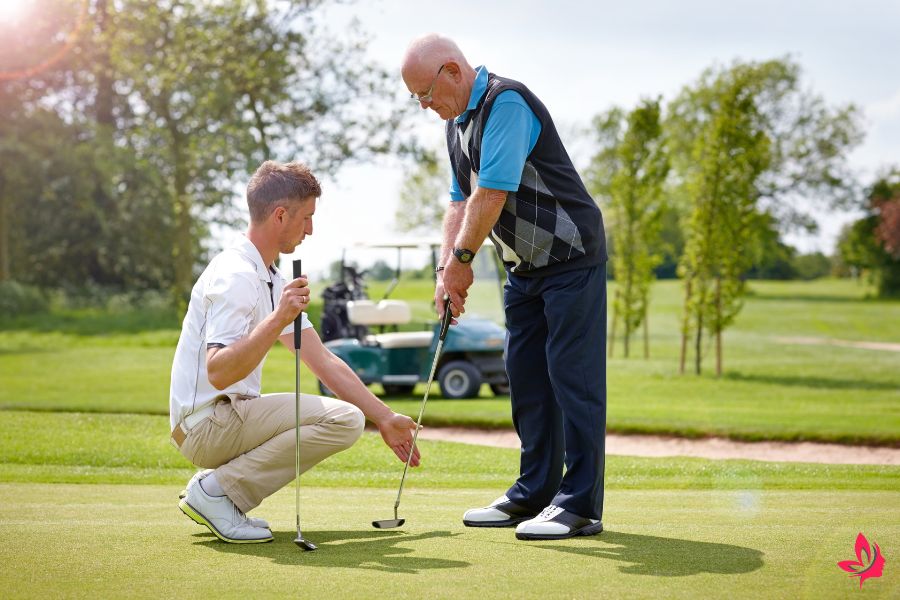The average golf handicap for seniors can be a real source of frustration. As golfers age, they often watch their scores creep higher and wonder if there’s any way to turn things around.
Many senior golfers struggle with handicaps that have climbed since their younger days. Improvement might feel out of reach, but honestly, it’s not impossible—just trickier.
Most seniors carry handicaps ranging from 15 to 20. With the right approach to practice, strategy, and a little understanding of the World Handicap System, they can actually lower their scores and keep golf fun, no matter their age.
So, what does a realistic handicap look like for seniors? The trick is finding strategies that work with, not against, the changes that come with getting older.
Understanding the Average Golf Handicap for Seniors: What’s Typical and Why It Matters

The average golf handicaps for seniors typically range from 15 to 25. These numbers reflect not just experience, but also physical changes that come with age.
The World Handicap System helps by standardizing measurements, ensuring fair competition across all age groups and skill levels.
Current Average Handicap Index Among Senior Golfers
Golfers over 60 tend to have an average handicap index between 18 and 22. That’s pretty normal as swing speed and flexibility decrease.
Most senior men see handicaps in the mid-teens to low twenties. Senior women often have handicaps from 25 to 35, and plenty carry official handicaps above 30.
Key factors affecting the senior handicap range:
- Physical changes impacting swing speed
- Reduced flexibility and strength
- Course management experience
- Equipment adjustments
The United States Golf Association states that recreational players over 60 comprise a significant portion of the golfing population. Very few seniors—fewer than 10 %—keep single-digit handicaps after the age of 65.
What Average Round Score Looks Like for Senior Players
The average golfer shoots about 92 on a par-72 course. Seniors usually score between 90 and 100.
Scores shift depending on course difficulty and conditions. On easier tracks, seniors might shoot in the high 80s or low 90s. More challenging courses can push scores into the upper 90s or even low 100s.
Typical scoring patterns for seniors:
- Front nine: 45-50 strokes
- Back nine: 47-52 strokes
- Total average: 92-102 strokes
The weather can significantly impact senior scores. Wind or cold might add 5-8 strokes, and things like firm greens or thick rough don’t help either.
How the World Handicap System Ensures Fair Play Across Ages
The World Handicap System levels the playing field by standardizing handicap calculations for all golfers. It examines course rating and slope rating to ensure that handicaps are adjusted reasonably.
Senior golfers benefit from these consistent calculations, regardless of where they play. The system takes into account course difficulty, ensuring fair competition among all ages and skill levels.
WHS benefits for seniors:
- Standardized calculations worldwide
- Course difficulty adjustments
- Fair competition across age groups
- Consistent handicap portability
The system uses a golfer’s best 8 scores from their last 20 rounds. This provides a reasonably accurate representation of current ability—not just the old glory days.
Handicap Index vs. Course Handicap: The Difference for Seniors
The handicap index indicates a player’s potential on a standard course. Course handicap adjustments are made based on the course’s difficulty and the tees you play from.
Seniors often use forward tees, so their course handicap adjusts automatically. This ensures fairness, regardless of where they start.
Calculation differences:
- Handicap Index: Universal measure of ability
- Course Handicap: Course-specific adjustment
- Playing Handicap: Final strokes received in competition
This distinction matters because seniors play different courses, and the system keeps their handicap accurate everywhere.
What Is Considered a “Good” or “Low” Handicap for Seniors
A good handicap for senior men is usually between 15 and 20. For women, it ranges from 20 to 28. These are solid numbers, considering the physical changes that come with age.
Single-digit handicaps in this group are rare, indicating regular practice and solid fitness. Fewer than 5% of seniors keep their handicap below 10.
Handicap quality benchmarks for seniors:
- Excellent: Under 12
- Very Good: 12-18
- Good: 18-25
- Average: 25-30
- Improving: Above 30
Better senior players focus on the short game and course management more than distance. They know that avoiding penalty strokes and managing tough spots is the real key to lower scores.
How Regular Practice and Strategy Can Help Seniors Lower Their Golf Handicap

Consistent practice and smart course management help seniors lower their handicap, even as their bodies change. Equipment choices and realistic goals also lay the groundwork for improvement.
Targeting Lower Scores Through the Short Game and Putting Green
The short game offers the fastest way to better scores for seniors. Most strokes are lost within 100 yards of the green.
Seniors should spend about 60% of their practice time on chipping, pitching, and putting. Short game skills tend to stick around longer than full-swing power.
On the putting green, focus on:
- Distance control from 3-6 feet
- Lag putting from 20-40 feet
- Reading green slopes and breaks
Bump and run shots are great for seniors with knee trouble. They require less bending and deliver steady results around the green.
The Role of Regular Practice in Achieving a Single-Digit Handicap
Sticking to a practice schedule helps seniors maintain their swing and muscle memory. Most scratch golfers practice 3-4 times a week with specific goals in mind.
Seniors often get more from shorter, focused sessions. Forty-five minutes is enough to work on skills without getting tired.
Practice should include:
- Swing tempo work with training aids
- Course simulation with different lies
- Mental game preparation through visualization
Golf training aids like the Orange Whip can help maintain tempo and build strength. These tools are convenient for seniors who’ve lost some flexibility.
Choosing the Right Golf Clubs for Better Performance
Seniors lower their handicaps by selecting clubs that match their current swing speed, rather than what they used to swing. Modern equipment provides a significant boost to players who don’t hit as hard as they used to.
Hybrid clubs are a game-changer, replacing tough long irons and offering better launch. Some seniors even swap hybrids down to the 7-iron for more consistency.
Here’s what to look for:
- Senior flex shafts for more clubhead speed
- Bigger sweet spots on drivers and irons
- Higher lofted drivers (12-15 degrees) for extra carry
- Oversized grips to ease hand tension
Getting properly fitted clubs can drop a senior’s handicap by 2-4 strokes almost overnight. Better contact and distance control really make a difference.
Adapting to Course Difficulty and Weather Conditions
Smart course management matters more as seniors adapt to physical limits. Understanding course and slope ratings helps them make smart choices that protect their scores.
Seniors should move up to tees that match their current driving distance. Usually, that means playing one set forward from where they used to tee off.
Weather tips:
- Use an extra club in cold weather
- Pick safer targets when it’s windy
- Adjust strategy for firm or soft course conditions
Playing to strengths and resisting the urge for miracle shots usually leads to better scores and lower handicaps.
Being Realistic: Average Handicap Index for Older Golfers and How to Beat It
The average senior golf handicap ranges from 18 to 25 for those over 65. Still, focused seniors can do much better with consistent effort.
Realistic goals for seniors:
- 15-18 handicap for casual golfers who don’t practice much
- 10-15 handicap for regulars practicing weekly
- Single-digit handicap for dedicated golfers with good coaching
Many seniors see real progress in their first year of focused practice. The trick is setting achievable goals and celebrating the wins—no need to compare yourself to your younger self or the younger crowd.
Leveraging the World Handicap System and USGA Insight to Improve Your Game as a Senior

The World Handicap System gives seniors the tools to track progress and compete fairly, no matter where they play. Knowing how handicap index stats and course ratings work helps older golfers set smart goals and keep expectations realistic.
Why the World Handicap System Levels the Playing Field for Older Golfers
The World Handicap System launched in 2020 with seniors in mind. Now, both casual and competitive rounds count for handicap purposes.
This flexibility really helps older players who play more casual golf than tournaments. You only need 54 holes from any mix of rounds to set up an official handicap.
Key benefits for seniors include:
- Daily handicap updates that factor in weather
- Maximum handicap limit of 54.0 for everyone
- Net double bogey scoring limit—one bad hole won’t ruin your handicap
The USGA implementation makes handicaps portable worldwide. That’s a huge perk for retirees who travel or move around.
Statistics You Should Know: Handicap Index Trends Among Seniors
Senior golfers usually carry higher handicaps than younger players. That’s more about natural physical changes than a lack of skill or drive to improve.
The average golf handicap for seniors falls between 18-28 for men. For women, it’s typically 24-36.
Handicap distribution among senior golfers:
- 15% achieve single-digit handicaps
- 35% maintain handicaps between 10-18
- 40% play with handicaps between 19-28
- 10% exceed 28 handicap index
Most seniors notice their handicap creeping up by 1-2 strokes per decade after 65. Still, regular practice and tweaking your equipment can slow that down a lot.
The National Golf Foundation says scratch golfers over 65 make up less than 2% of seniors. Bogey golfers—those with a handicap around 18-20—form the largest chunk of recreational players at this age.
Understanding Course Rating, Slope Rating, and Their Impact on Seniors
Course rating tells you what a scratch player should shoot under normal conditions. Slope rating measures how tough a course is for bogey golfers compared to scratch players, running from 55 to 155.
Seniors really benefit from knowing these ratings when picking tee boxes. Course handicap calculations adjust based on both ratings.
Strategic tee selection for seniors:
- Forward tees often reduce slope rating by 10-15 points
- Course rating drops by 2-4 strokes from back to forward tees
- Lower slope ratings help higher handicap players more
Weather adjustments matter more for older players. The World Handicap System factors in abnormal course conditions that hit senior golfers’ scores harder than you’d think.
Tracking Progress: From Amateur Golfer to Bogey Golfer to Scratch Player
Improvement for seniors often follows a familiar pattern—if you stick with practice. The handicap system uses your best eight scores from the last 20 rounds.
Realistic improvement timeline for seniors:
- Beginner to 28 handicap: 6-12 months
- 28 to bogey golfer (18-20): 12-24 months
- Bogey golfer to 12 handicap: 24-36 months
- Single-digit handicaps: 3+ years of dedicated practice
Better scores usually come from working on your short game, not chasing more distance. Seniors should put more time into putting and chipping than pounding balls at the range.
The mental side of golf becomes increasingly important as physical skills begin to fade. Smarter course management almost always beats trying hero shots you probably shouldn’t attempt.
Good News: Even Older Golfers Can Significantly Lower Handicap Index Over Time
Recent statistics indicate that motivated senior golfers can reduce their handicap index by 5-8 strokes in two years. The secret? Targeted practice and goals that actually make sense for your game.
Modern tech helps seniors dial in their games way better than before. Launch monitors and swing analysis show exactly what needs fixing.
Proven strategies for handicap reduction:
- Cut out penalty strokes
- Get sharper on the greens
- Pick clubs that fit slower swing speeds
- Play easier courses to build confidence
Plenty of seniors shoot their best scores after 60, especially with more time to practice. Country clubs report that retired members often experience significant handicap drops in their first year of retirement.
Frequently Asked Questions
Senior golfers often have questions about handicap standards and what scores to expect. Most people over 50 face unique challenges that increase their handicap compared to younger players.
Handicaps vary significantly by age group. The average golf handicap by age reveals that younger golfers tend to maintain lower handicaps, primarily due to physical advantages.
In your 20s and 30s, men typically average 12-16, and women average 20-24. Once you reach your 40s and 50s, the risk increases to 14-18 for men and 22-26 for women.
Senior golfers over 50 typically have higher handicaps because their strength and flexibility tend to decline. Men over 60 average 16-20, while women land at 24-28.
By 70, handicaps often rise to 18-22 for men and 26-30 for women. It’s just the way aging goes.
A 17 handicap golfer typically shoots 89-93 on a par 72 course. This player gets 17 strokes of relief during handicapped play.
The handicap system takes into account both course difficulty and slope. A 17 handicap means you’re a solid recreational golfer, but consistency is still a work in progress.
These golfers break 90 about half the time. On a great day, they might hit the mid-80s, but tough rounds can creep into the upper 90s.
Breaking 85 isn’t easy. Studies say only 15-20% of golfers do it regularly.
This number drops even further for seniors due to lost distance and flexibility. Age makes it more challenging.
Golfers who break 85 usually have single-digit or low double-digit handicaps. They know how to manage a course and keep their short games sharp.
Shooting 83 is fantastic for most recreational golfers. That score puts you in the 10-12 handicap range, which is top 25% territory.
For seniors, an 83 is even more impressive. The effects of physical fitness on senior golf performance show that it’s tough to maintain that level as you age.
Most players never see an 83. If you do, you’re showing off some serious all-around skills.
A handicap lower than 14 for men and less than 28 for women is better than average. These players are steady and manage the course well.
For seniors, a mid-teens handicap means you’re playing solid recreational golf. It shows you how to practice and understand the basics.
Single-digit handicaps? That’s excellent at any age. These golfers shoot in the 70s and low 80s pretty often.
If you’re between 10 and 18, you’re a committed recreational player. You develop a course strategy and can execute most shots when it counts.
Breaking 70—wow, that’s rare. Fewer than 1% of all golfers ever pull it off.
You need exceptional skill, tons of practice, and sharp course management to get there. It’s really not for the faint of heart.
For senior golfers, breaking 70 gets even tougher. Distance isn’t on their side, and the physical grind only ramps up with age.
Professionals and scratch golfers are the ones who can consistently break 70. These folks keep their handicaps at zero or even below.
Most recreational golfers, no matter how old, probably won’t ever see a 69 on their card. That number is almost like a unicorn—it’s reserved for those with years of dedication and a bit of natural talent.

